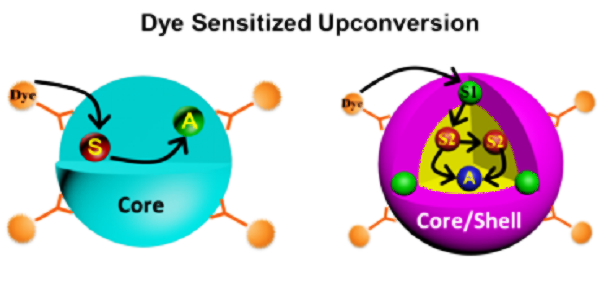Reported by: Yan Mingxing
Translated by: Han Jie
Edited by: Garrick Jones
Date: June 19th, 2017
Recently, Professor Chen Guanying of the School of Chemistry and Chemical Engineering (member of Key Laboratory of Micro-system and Microstructure Manufacturing, Ministry of Education) and his team published a Tutorial Review paper entitled Dye-sensitized Lanthanide-doped Upconversion Nanoparticles in Chemical Society Reviews subordinated to the Royal Society of Chemistry. Chemical Society Review is one of the most influential and authoritative chemical and chemical review academic journals, and the latest released impact factor is 38.618 in 2017. The Tutorial Review paper aims to guide education and commentary on the international frontier in emerging research areas, with a view to attracting more global researchers' attention and research. The first author of the paper is Wang Xindong, the Ph.D. candidate enrolled in 2016 at our school. Professor Chen Guanying is the only corresponding author, and HIT is the first and only communication unit.
Based on the research work of professor Chen Guanying in recent years, this paper focuses on the problem of weak and narrow absorption of lanthanide ions. This tutorial review highlights recent progress in the development of dye sensitized UCNPs, with an emphasis on the theory of energy transfer, the geometric classification of dye sensitized core and core/shell nanocrystals, and their emerging photonic and biophotonic applications. It is concluded that organic dyes transferred via Förster and/or Dexter mechanisms across the organic/inorganic interface to the lanthanides incorporated in UCNPs (with or devoid of a shell) to empower efficient upconversion., and the energy transfer process of core and core-shell structures of lanthanide metal doped nanocrystals which are dye-sensitized, and concluded the application prospect of the dye-sensitized nanocrystalline in photovoltaic cell, security patch, near-infrared card, biological imaging and optogenetics. The work laid the foundation for the research of dye-sensitized lanthanide-based metal-doped nanocrystals, which led the advance of the discipline.
At present, lanthanide-based metal-doped upconversion luminescence nanocrystals have the advantages of narrow emission spectra, long luminous life, high photochemical stability and large displacement of anti-Stokes. It also shows great potential for application in biomechanics, multimodal imaging, tumor photodynamics, solar cells and other fields. Yet, the weak and narrow absorption of lanthanide ions poses a fundamental limit of UCNPs to withhold their brightness, creating a long-standing hurdle for the field. In recent years, construction of dye cascade sensitized lanthanide doped luminescent nanocrystals as proposed by professor Chen Guanying effectively solves this difficult problem, and has been successfully applied in near-infrared biological imaging, multi-color displays, photovoltaic cells and other fields. The related research results are published in the Journal of the American Chemical Society (2016, Vol. 138, pp. 16192-16195) and Nano Letter (2015, Vol. 15, pp. 7400-7407) and other international journals, and aroused widespread interest at home and abroad. In view of the importance of this work, professor Chen Guanying was invited to publish the first Tutorial Review paper in the Chemical Society Review.
The above work has been financially supported by the National Natural Science Foundation of China general program, the National Youth Talent Support Program, the HIT Major Talent "Leap Plan", Swedish Energy Agency and Shenzhen University Initial Fund.
Link to the paper: http://pubs.rsc.org/en/content/articlelanding/2017/cs/c7cs00053g#!divAbstract



